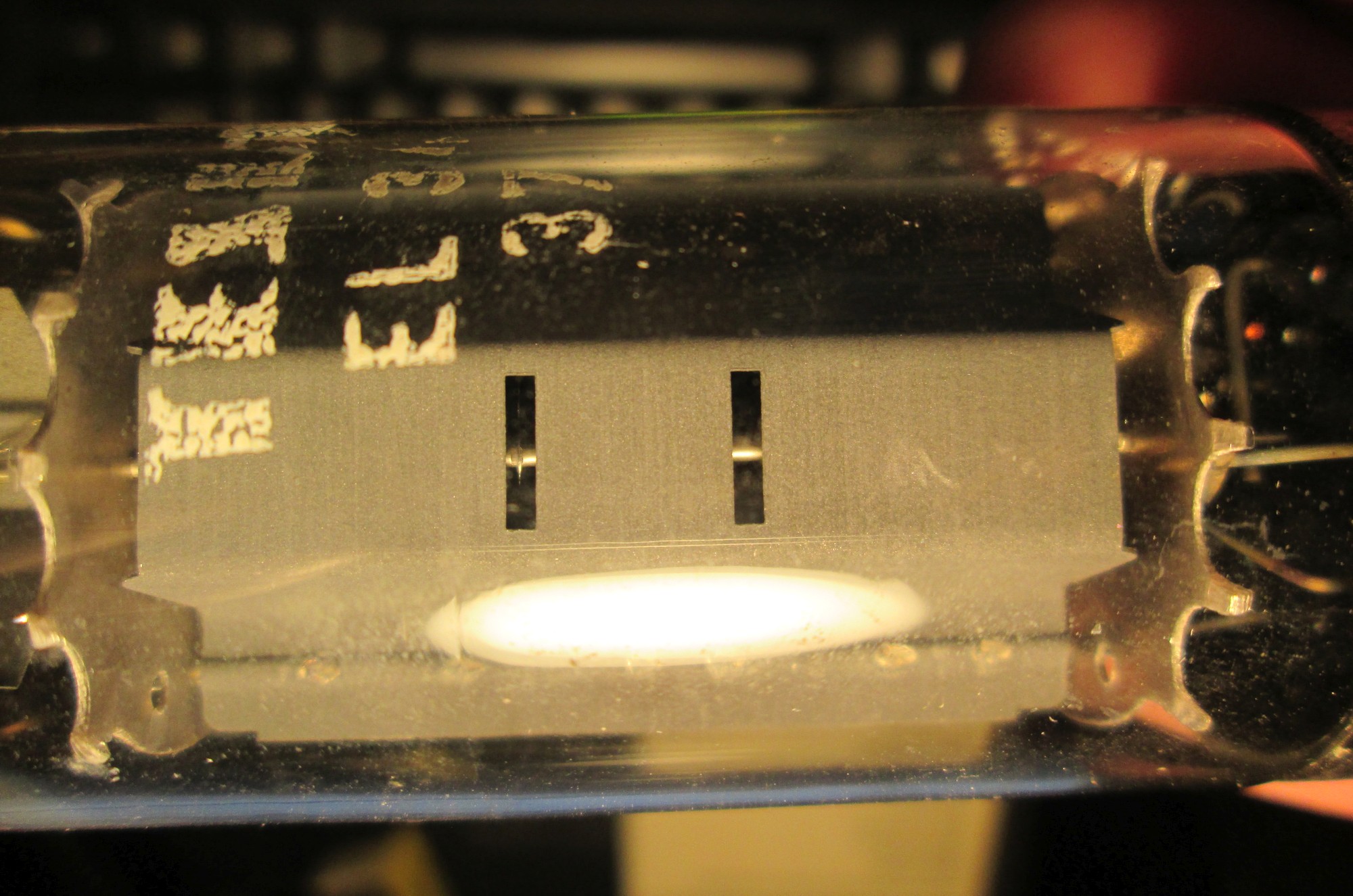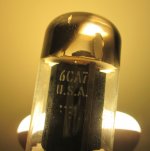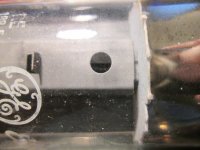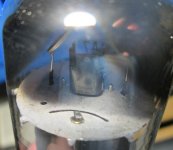I have to replace EL34's in an amp used for music, as opposed to a guitar amp. Opinions on brand? I hear JJ Electronics may be best?
Thanks
Thanks
JJ are a name and depending on what you require; Chinese to Mullard UK, you must ask when purchasing. Some are good, some are terrible.
I use KT66 when I have run out of Svetlana Winged 'C' EL34s. 6L6GC will do nicely if you warm up the bias a little.
All valves need to be biased correctly for the sweet sound that you require.
I use KT66 when I have run out of Svetlana Winged 'C' EL34s. 6L6GC will do nicely if you warm up the bias a little.
All valves need to be biased correctly for the sweet sound that you require.
Svetlana Winged 'C' EL34s bias
Say more about the warm up the bias a little please. I have seen good reviews on the Svetlana though not sure if it was the Winged C. Thanks
Say more about the warm up the bias a little please. I have seen good reviews on the Svetlana though not sure if it was the Winged C. Thanks
Users in the audio world are said to prize the EL34 Mullard-Groove Tubes Super Premium very highly.
Watford Valves, one of Europe's leading suppliers of tested, graded and guaranteed valves to the professional music industry.
Watford Valves, one of Europe's leading suppliers of tested, graded and guaranteed valves to the professional music industry.
JJ are ok, made in slovakia ( EU). Eurotubes.com sells themI have to replace EL34's in an amp used for music, as opposed to a guitar amp. Opinions on brand? I hear JJ Electronics may be best?
Thanks
matched to your amp ( always buy matched set.
Say more about the warm up the bias a little please. I have seen good reviews on the Svetlana though not sure if it was the Winged C. Thanks
They have been out of production for a while now. If you can find them, they will be expensive.
jeff
Don't confuse current Svetlana production with SED or Winged C product. The current stuff is made by the New Sensor Expo Pul plant in Saratov and have absolutely nothing to do with the old Svetlana (SED) or Winged C tubes which were made by Svetlana SPb in St. Petersburg. They no longer manufacture tubes for audio, and have become rarer and more expensive over time.
The EH tubes are OK according to several people I know, but I use NOS XF2/XF3 Mullards where I need EL34s. (I used them in voltage regulators)
The EH tubes are OK according to several people I know, but I use NOS XF2/XF3 Mullards where I need EL34s. (I used them in voltage regulators)
I agree with petertub.
Whenever possible I use JJ tubes. I always purchase JJs from Eurotubes.com. Eurotubes does extensive re-testing of all the tubes they get from JJ in Slovakia. And I always buy matched pairs from Eurotubes. They all have given me good tube life (did not need to replace any of them). I use them in Hi Fi application, I do not have any guitar amplifiers, but I know they work there too.
If JJ does not make the tube type I want, then only do I purchase tubes somewhere else.
Whenever possible I use JJ tubes. I always purchase JJs from Eurotubes.com. Eurotubes does extensive re-testing of all the tubes they get from JJ in Slovakia. And I always buy matched pairs from Eurotubes. They all have given me good tube life (did not need to replace any of them). I use them in Hi Fi application, I do not have any guitar amplifiers, but I know they work there too.
If JJ does not make the tube type I want, then only do I purchase tubes somewhere else.
In order to answer the OP intelligently, one would need to know more about the amp in question.
Is the amp push-pull, or is it single-ended? Are the EL34s run in ultralinear mode (screen taps on the output transformers)? Are the EL34s run in pentode mode? What is the plate (anode) to cathode voltage on the EL34s? If pentode mode, what is the screen voltage on the EL34s?
There is a different version of EL34 called 6CA7, which can be a very robust type. The two that appear to be commonly available are from JJ Electronics (Slovak Rep.) and Electro-Harmonix (Russia).
6CA7 is a beam tetrode, while EL34 is supposed to be a true pentode (with a suppressor grid instead of beam forming plates). I don't think that's as important as getting a compatible tube that works well, sounds okay, and is reliable. I've seen too many Russian and Chinese EL34s burn up and/or melt down.
At any rate, 6CA7 is and has always been a direct replacement for EL34, so you might consider those too, especially if your amp's output stage is ultralinear-type.
Happy shopping! --
Is the amp push-pull, or is it single-ended? Are the EL34s run in ultralinear mode (screen taps on the output transformers)? Are the EL34s run in pentode mode? What is the plate (anode) to cathode voltage on the EL34s? If pentode mode, what is the screen voltage on the EL34s?
There is a different version of EL34 called 6CA7, which can be a very robust type. The two that appear to be commonly available are from JJ Electronics (Slovak Rep.) and Electro-Harmonix (Russia).
6CA7 is a beam tetrode, while EL34 is supposed to be a true pentode (with a suppressor grid instead of beam forming plates). I don't think that's as important as getting a compatible tube that works well, sounds okay, and is reliable. I've seen too many Russian and Chinese EL34s burn up and/or melt down.
At any rate, 6CA7 is and has always been a direct replacement for EL34, so you might consider those too, especially if your amp's output stage is ultralinear-type.
Happy shopping! --
Say more about the warm up the bias a little please.
The grid to cathode voltage will need to be different if you install 6L6GC instead of EL34. If you put a 6L6GC tube in a circuit designed for EL34, the 6L6GC will draw a different amount of plate current. How much different depends on the design of the amplifier.
6L6GC is similar to EL34, but still different enough that you can't just plop a set of 6L6GCs into an EL34 amp and expect to get good results. You will need to modify the amp to convert it to use 6L6GC well.
On the other hand, 6CA7 is a 6L6GC-type beam tetrode with EL34 characteristics. You can plop a set of 6CA7 tubes into an EL34 amp and expect good results. That's because 6CA7 was designed to be a direct replacement for EL34.
--
Edit to add:
One exception I found is the Russian 63PS-E tube (sold by Sovtek as a 5881, but it's not that at all). In a Dynaco Stereo 70, you can drop in a quad of 6P3S-E and they'll bias up about the same as the original EL34 set. So at least they're safe to use in most cases. They do sound different, though. I can't say if you'd like it better or not.
Last edited:
rongon,
GE, Tungsol, and RCA data sheets all say that the 6CA7 is a Pentode (not Beam Power).
JJ calls the 6CA7 a Beam Power Pentode (I do not have one, so I can not look for the characteristic sheet metal beam forming elements of a Beam Power tube; Or look for characteristic grid supporting vertical posts of the Pentode suppressor grid).
Phillips, Telefunken, Mullars, Tesla, and JJ all say that the EL34 is a Pentode.
The 6CA7 and EL34 all connect the suppressor grid to pin 1 (the suppressor is not internally connected to the cathode).
If you want a true Beam Power tube, get a GEC, MO Valve, or JJ KT77. Those data sheets all say the KT77 is a Beam Power tube. Pin 1 is not connected (NC). The Beam Forming Electrode is connected internally to the cathode. The KT77 is the closest replacement for the 6CA7 and EL34 if you want to hear your amp with a true Beam Power tube
And . . . There is similar confusion of the 6BQ5 and EL84. A GE data sheet says the 6BQ5 is a Beam Power tube. But all the other data sheets I looked at say the 6BQ5 is a Pentode. All the EL84 data sheets I looked at say the EL84 is a Pentode. But I have seen some tubes labeled 6BQ5 with beam forming elements, and some 6BQ5 with suppressor grids.
Just look at the tubes you have, and determine for yourself if it is a Beam Power tube, or a Pentode tube.
GE, Tungsol, and RCA data sheets all say that the 6CA7 is a Pentode (not Beam Power).
JJ calls the 6CA7 a Beam Power Pentode (I do not have one, so I can not look for the characteristic sheet metal beam forming elements of a Beam Power tube; Or look for characteristic grid supporting vertical posts of the Pentode suppressor grid).
Phillips, Telefunken, Mullars, Tesla, and JJ all say that the EL34 is a Pentode.
The 6CA7 and EL34 all connect the suppressor grid to pin 1 (the suppressor is not internally connected to the cathode).
If you want a true Beam Power tube, get a GEC, MO Valve, or JJ KT77. Those data sheets all say the KT77 is a Beam Power tube. Pin 1 is not connected (NC). The Beam Forming Electrode is connected internally to the cathode. The KT77 is the closest replacement for the 6CA7 and EL34 if you want to hear your amp with a true Beam Power tube
And . . . There is similar confusion of the 6BQ5 and EL84. A GE data sheet says the 6BQ5 is a Beam Power tube. But all the other data sheets I looked at say the 6BQ5 is a Pentode. All the EL84 data sheets I looked at say the EL84 is a Pentode. But I have seen some tubes labeled 6BQ5 with beam forming elements, and some 6BQ5 with suppressor grids.
Just look at the tubes you have, and determine for yourself if it is a Beam Power tube, or a Pentode tube.
Last edited:
You may be right 6A3sUMMER. I have some old GE 6CA7 here, and a an early 1990s Tesla EL34. I also have a 1970s RCA 6L6GC to compare them to.
I've attached some photos of the innards (through the glass; I'm not smashin' these). Any way to tell from these photos?
--
First batch, GE 6CA7
The base has all 8 pins
I've attached some photos of the innards (through the glass; I'm not smashin' these). Any way to tell from these photos?
--
First batch, GE 6CA7
The base has all 8 pins
Attachments
Last edited:
Second batch, RCA 6L6GC
The base has pins 1 and 6 omitted
The base has pins 1 and 6 omitted
Attachments
Last edited:
Last batch, Tesla EL34
The base has all 8 pins
I hope this is useful...
The base has all 8 pins
I hope this is useful...
Attachments
Last edited:
One more, a Philips ECG 6CA7 from the 1980s.
If I'm looking at this correctly, it's easy to see the coarse windings of the suppressor grid through the holes in the side of the stamped plate (anode). At least that's what I think I'm looking at (see attached photo 19_6CA7_SYL.jpg).
If I'm looking at this correctly, it's easy to see the coarse windings of the suppressor grid through the holes in the side of the stamped plate (anode). At least that's what I think I'm looking at (see attached photo 19_6CA7_SYL.jpg).
Attachments
Aaaa-HAH!!
Here are a couple more photos of the GE 6CA7. Look inside the holes in the plate. You can't see a wound grid. You see another sheet of gray stamped metal. Isn't that a beam former? Take a look and tell me what you think...
Here are a couple more photos of the GE 6CA7. Look inside the holes in the plate. You can't see a wound grid. You see another sheet of gray stamped metal. Isn't that a beam former? Take a look and tell me what you think...
Attachments
And take another look at the Tesla EL34. You can see inside the plates there's a coarsely wound grid, which I think is the suppressor grid (g3). Right?

Unless I'm mistaken, it appears the Philips/ECG (Sylvania) 6CA7 is indeed a power pentode, but the GE 6CA7 is a beam tetrode.
Unless I'm mistaken, it appears the Philips/ECG (Sylvania) 6CA7 is indeed a power pentode, but the GE 6CA7 is a beam tetrode.
Last edited:
A couple more photos of beam tetrodes. The first two are of a New Sensor/Svetlana 6L6GC. The last one is of an old Chinese 6550A (branded Pro-Comm).
You can see the beam formers inside the plates. In a couple of the photos you can just make out the screen grids showing through square holes in the beam formers.
The Svetlana 6L6GC is missing pins 1 and 6.
The 6550A is missing pin 6 only.
Let me know if I've got this all wrong. I hope this is helpful...
You can see the beam formers inside the plates. In a couple of the photos you can just make out the screen grids showing through square holes in the beam formers.
The Svetlana 6L6GC is missing pins 1 and 6.
The 6550A is missing pin 6 only.
Let me know if I've got this all wrong. I hope this is helpful...
Attachments
Last edited:
- Status
- Not open for further replies.
- Home
- Amplifiers
- Tubes / Valves
- tube recommendation for EL34 replacement

























